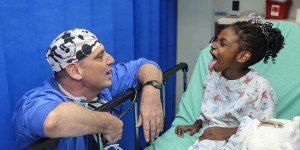Medical Paediatrics
Roles
Rota
Banding: 1A
Rota Master: Dr. Laura Jones (Laura.Jones@nhslothian.scot.nhs.uk)
General Pattern of Work
You will rotate through various departments within medical paediatrics and spend time in the acute receiving unit (ARU), A&E and specialty wards: haematology/oncology, GI, neurology and respiratory.
ARU: Your day starts at handover (held in the HAN handover room, near Ward 6, which is a room primarily used as a base for the ARU team). The night team will hand over to a team consisting of 2 Consultants on call for the week, both senior and junior paediatric STs and one or two FYs/GPSTs. Patients will be split, as will the team, and a ward round follows handover, followed by a further handover back in the HAN room usually around lunchtime to confirm tasks for the day. You will spend the rest of the day generally completing tasks for the set of patients you have seen: IDLs should be done promptly, bloods taken, investigations ordered and chased, and reviews (mainly wheeze reviews) undertaken. ST 1-2s will review and admit medical referrals from A&E, which rarely requires input from the FY; however, you will have the responsibility of ensuring any outstanding investigations or reviews are carried out on the patient’s arrival on the ward. These should be communicated to you (and the rest of team) by both the ST and nursing staff. Remember to edit the relevant handover document after completing an investigation/altering management of a patient – these are located in the Paediatrics shared drive which everyone should have access to.
A&E: Your time spent here will be as a member of the A&E team. You will see patients following triage, requiring you to carry out a full history and examination and construct a preliminary diagnosis and management plan. Carry out investigations as appropriate and present your case to a senior (preferably the Consultant on for the day). NB: you are a member of the paediatric emergency team (PET) whilst in A&E; please ensure you remember to pick up this bleep from the night FY finishing or day A&E FY accordingly.
Specialties: You will likely spend time on at least 2 specialty wards, and everyone rotates for at least a week through GI/endocrine. As the junior part of a specialty team, your day will usually consist of a daily ward round with a senior registrar or consultant, followed by ward duties. One member of each speciality team will attend handover at 4:30pm in the HAN room to hand over any outstanding tasks or reviews for the evening or night team.
Discharge letters: These are completed often days in advance of patients going home, and handed to pharmacy so their drugs can be prepared in advance and prevent delayed discharge. Often the doctor who admits the child will start the IDL, but it is each team’s responsibility to ensure it doesn’t get missed and left till the last minute. This is particularly relevant on a Friday, as pharmacy have very limited opening hours over the weekend.
Standard day: 9am to 5pm
Ward duties as normal. Haematology/Oncology starts at 8:30am most days, and neurology starts at 8:30am on Fridays.
Long day: 9am to 9:30pm Pink
Ward duties as normal until 5pm. Carries the FY on-call bleep and covers all medical wards from 5pm to 9:30pm. Receive handover from the various specialties and complete tasks handed over, and respond to bleeps as appropriate. The majority of tasks are usually for ARU. Hand over remaining tasks to the night team.
Long day: 9am to 9:30pm Green
Ward duties as normal until 5pm. Covers A&E from 5pm to 9:30pm. Pick up the PET bleep from the A&E day FY, and remember to pass it onto the night FY at the end of your shift.
Nights: 9pm to 9:30am
There is no formal hospital at night team but it operates more or less like one. The team will consist of one FY/GPST, an ST1/ST2 (tier 1) responsible for admissions and a senior ST (tier 2/registrar) covering the hospital. There is also the clinical co-ordinator (senior nurse) who attends handover and will catch up with you during the night. This shift begins at 9pm handover in the HAN room. Evening handover can be a little overwhelming, but this is aided by ensuring you have a copy of all patient lists (ARU and specialities; this is normally the responsibility of the evening team to supply), and keeping track of tasks throughout handover. Communication with the other members of your team will ensure tasks are appropriately divided, and senior support is always available to you.
Weekends: Friday, Saturday and Sunday 9am to 9:30pm
On Fridays, you attend to your usual ward duties until 5pm, and spend the evening in A&E. On Saturdays and Sundays, you will be expected at the 9am ARU handover, and to participate in the ARU ward round. Once this is completed and immediate tasks have been carried out, you spend the rest of the day (usually from 1pm onwards) in A&E. Be sure to have lunch before starting in A&E as it can be difficult to take breaks for food in A&E. At times, you may be expected to attend A&E earlier, or help out in ARU for longer, depending on where the workload is greatest. Hand your PET bleep over to the night team before you leave.
ARU: Base is Ward 6, patients all over hospital
GI: Base is GI office (9 Rillbank Terrace), patients all over the hospital
Respiratory: Ward 1
Haematology/oncology: Ward 2
Neurology: Ward 7
Admin
IDLs Shortcuts
There are numerous shortcuts to IDLs for many ARU presentations e.g. viral induced wheeze, asthma exacerbation and bronchiolitis. These are available in the HAN room and the Ward 6 and Ward 1 doctors' rooms, and will not take long to memorise! All follow the simple pattern on \aru… For other presentations you can use the shortcut \idl and fill in the appropriate sections
Follow Up
If you think any ARU cases require follow-up on discharge, this can be arranged in the form of a Consultant ARU clinic, a simple medical review or task undertaken in PIU, or referral to another specialist nurse/clinic. There are referral forms kept in the HAN room.
Copy discharge letters for patients who need asthma follow up to Ann McMurray; for UTI follow up to Tracey McGregor and for allergy follow up to Susan Brown.
Clinical
Wheeze reviews
One of the most frequent reviews undertaken whilst part of the ARU/OOH team is for those admitted with wheeze. Based on a MDI response, aiming to stretch from 1-hourly to 4-hourly MDIs. Record the time since last MDI, sats, RR, work of breathing and heart rate. Examine general state and auscultate chest. If improving increase time interval between inhalers e.g. from 1 to 2-hourly; if worse reduce time interval and consider senior review or further management e.g. combinebs. Review again after 2-3 doses. Once 4-hourly, no longer needs regular review.
How do I prescribe a multidose?
Medicine (approved name) - Salbutamol
Dose - 10 puffs
Route - INHAL via Spacer
Notes - 100 microgram MDI
Fluid reviews
Look for signs of dehydration through their observations e.g. tachycardia, tachypnoea, low BP (a late sign of shock in children), or on examination e.g. sunken fontanelle/eyes, increased CRT, dry mucous membranes. Evaluate what kind of fluid they require (based on clinical examination and electrolytes), the volume and the rate. Daily U&Es while on IV fluids (gas/lab), and 12-hourly blood glucose levels if infant under 12 months are required.
Fluid bolus: 10-20ml/kg of 0.9% NaCl can be given acutely for shock, reassess post bolus. 3ml/kg 10% glucose for hypoglycaemia.
Fluid Deficit: Estimate any fluid deficit and replace as sodium chloride 0.9% with glucose 5% or sodium chloride 0.9% over a minimum of 24 hours (longer if sodium high). Deficit (ml) = % dehydration x weight (kg) x 10.
Maintenance: The majority of children may be safely administered sodium chloride 0.45% with glucose 5%. In some circumstances, children should only ever be administered isotonic fluids such NaCl 0.9% with glucose 5%, NaCl 0.9%, Hartmann’s solution/Ringer-Lactate solution. Solution choice should be tailored to the patient’s needs. Potassium can be added once the plasma potassium concentration is known, up to 30mmol/500ml peripherally, or up to 40mmol/500ml if using central venous access.
Discuss neonates with a senior, usually require 10% glucose to maintenance fluids.
Ongoing fluid losses: Reassess ongoing fluid losses every 4 hours. Fluids used to replace ongoing fluid losses should ideally reflect the electrolyte composition of the fluid being lost. NaCl 0.9% is appropriate in most cases (+/- potassium) or Hartmann’s solution.
To estimate a child’s weight: 2 x (age in years + 4)
Antibiotics and prescribing
Every paediatric prescription is based on weight.
There are local protocols used at RHSC for IV antibiotics. These should be found in every treatment room of each ward, in an IV MONOGRAPHS folder, so please refer to this before prescribing IV antibiotics. This also includes IV paracetamol, which is restricted to use in PICU/HDU and surgical patients who are NBM.
Antibiotics for suspected sepsis of unknown origin:
Under 28 days - IV benzylpenicillin and gentamycin
28 days to 3 months - IV cefotaxime
Over 3 months - IV ceftriaxone
Paracetamol
15mg/kg, max 60mg/kg/day, is a standard dose for the ORAL or IV routes, in children under 3 months old and under 50kg.
Ibuprofen
Also a great anti-pyretic in children.
5mg/kg is a standard dose for most medical patients, 10mg/kg is used for surgical patients, maximum 30mg/kg/day.
Protocols
1. Useful Guidelines
SIGN 102 - Management of invasive meningococcal disease in children and young people
SIGN 91 – Bronchiolitis in children
NICE CG47 – Feverish illness in children
http://www.sprun.scot.nhs.uk/Clinical%20Area.html – Renal Protocols
BTS guidelines for the management of pleural infection in children
2. RHSC Guidelines: Management of Acute and Postoperative Pain and Pyrexia
Find this in: Paediatrics shared drive (Paediatrics – Pharmacy Induction for Junior Doctors) and INTRANET (RHSC policies and guidelines-Medicine prescribing and administration).
This gives oral, rectal and IV dosing for all ages.
Timetabling
Dr Laura Jones is responsible for the Junior Medical rota; she is primarily a paediatric consultant and manages the rota in her own time. FYs will have most weekends off, and on average 8 to 15 night shifts per 4-month block. Blocks of nights are either Monday to Thursday or Friday to Sunday, with ample time off either side. Annual leave is done by request and usually accommodated; each FY is entitled to 8 days leave plus extra days if working any public holidays. The rota is usually emailed out a few weeks prior to the block commencing, and FYs are asked to choose their top 3 lines from the existing template. You can also request extra time in a particular specialty if you have a special interest (Neuro, Respiratory, GI/Endocrine/Rheumatology, Haematology/Oncology, Acute Receiving Unit, A&E).
Clinical Meetings
ARU ‘10 at a time’ - Mondays 2pm, Ward 6 Doctors’ Office
RHSC Grand Rounds - Tuesdays 1pm, RHSC Lecture Theatre
FY1/2/GPST teaching - Tuesdays 2:15pm, RHSC Lecture Theatre
ARU Journal Club - Wednesdays 1pm, Registrar Room
Medical Radiology - Thursdays midday, CL&H Seminar Room
Medical ST/SpR teaching - Fridays 2pm, RHSC Lecture Theatre
Specialty teaching - Contact teams for details
Medical Paediatrics FY1
Medical Paediatrics FY2

